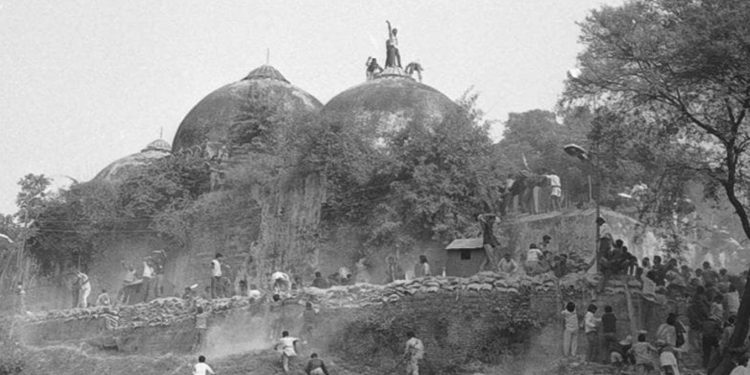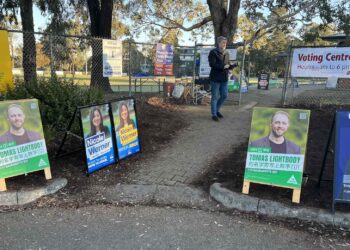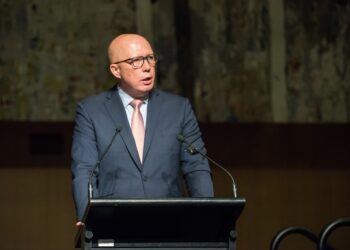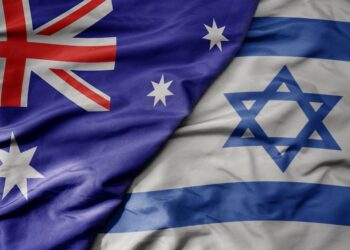t was Washington D.C., August 7, 1993.
The aroma was overpowering.
Samosas? Chole? In the lobby of Washington Hilton?
I wasn’t imagining. As I came down the elevator, I felt as if I had just joined an overcrowded Indian party. People were everywhere, eating and talking loudly. Used plates and cups left behind on the floor.
As I walked around hesitatingly, I came face-to-face with Ashok Singhal, President of the Vishwa Hindu Parishad (VHP), and Murli Manohar Joshi, Member of Parliament and President of the Bharatiya Janata Party (BJP), who were holding forth with other netas. Dothi and kurta-clad men in outsized tilaks stood in small groups talking animatedly in Hindi.
It was the 7th of August 1993, nearly eight months after Sangh Parivar mobs led by the VHP had demolished the 16th-century Babri Masjid in Ayodhya. In my imagination, it seemed as if the same mob had diabolically transported itself to the lobby of a Washington hotel!
I was told that they were getting ready for the weekend “Global Vision 2000” conference organized by the Vishwa Hindu Parishad of America (VHPA) at the Capital Center sports arena outside Washington, D.C. Many of the people in the lobby had apparently been flown in from villages in India’s “Hindi Belt.”
My curiosity had the better of me at that point. I decided to set aside all my plans for the weekend and melted into the crowd being ushered into waiting buses.
As we trooped into the Capital Center, I was surprised at the size of the crowd, which seemed impatient for the program to commence. Who would have thought that a gathering spear-headed by an extremist Hindu organization banned in India could bring as many as 10,000 people into an American arena, just months after it had delivered the most crushing blow to communal peace in post-independent India?
Anyway, there I was, a gate-crasher at the Global Vision 2000 conference, commemorating the centenary of Swami Vivekananda’s famous address to the World Parliament of Religions in Chicago in 1893. I was determined to take advantage of the unexpected chance to educate myself on the VHP and the Sangh Parivar.
A Crash Course on the VHP
As the program finally got underway, a huge map of Akhand Bharat (India, Pakistan, Nepal, Bangladesh, Afghanistan, Sri Lanka, and Burma combined), the unfulfilled dream of Hindu nationalists, filled the main screen. Moments later, the map had changed to the real India, perhaps making some in the audience think that the first slide may have been an error. But, for devotees of the VHP, a not-so-subtle ideological message had been delivered successfully at the very outset.
I remember telling myself that VHP’s wishful visual display was merely a continuation of cries of “vivisection of Mother India” by those who had little role in India’s independence movement. But today, when we hear renewed talk of Akhand Bharat by people proximate to power, including the head of the Rashtriya Swayamsevak Sangh (RSS), Mohan Bhagwat, I can’t help wondering if I should have taken the message far more seriously.
Soon after the map had been ‘corrected,’ everyone stood up for the national anthem. After a beautiful rendering of the Star-Spangled Banner by a young lady, I remained standing, fully expecting the Indian national anthem to follow. But it never came!
I am not a jingoist by any measure, but I was deeply disturbed. I had this intense urge to break out with Jana Gana Mana at the top of my voice. But the momentary urge to heroism melted away quickly, as I considered the real possibility of being assaulted by those around me, or even being ejected from the arena.
As I think about it today, it’s ironic that the same Sangh Parivar, which had refused to honor the national anthem and India’s national flag for decades, is now wrapping itself in the tiranga and accusing others of being anti-India.
Then came the final shocker: The giant overhead display was paying tribute to Swami Chinmayananda and identified him as a co-founder of the VHP. The well-known Hindu spiritual leader and teacher, who was held in very high regard by many in my family, had just passed away.
“Swami C,” as my daughter would refer to him while she was at a Chinmaya summer camp, was a co-founder of the VHP? Unbelievable.
It is not that the Chinmaya Mission promotes hate and violence in any way. In fact, the late Swamiji may have never countenanced the kind of hate speech that has become a trademark of the VHP. Yet, the fact that the Chinmaya Mission, which lent so much spiritual legitimacy to the VHP, should remain completely silent today, as India witnesses the vitriol and street violence led by today’s VHP, is hugely disappointing.
Planting Seeds of Hate
Thus began the two-day gala, memories of which still haunt me today, as India descends into a majoritarian fascist state, where street violence, arbitrary arrests, house demolitions of protesters, shutting down of press freedoms, intimidation of dissenters have become choice tools of the state. And the VHP and its affiliates such as the Bajrang Dal have become the primary street enforcers.
It is a huge irony that, today, it has fallen on the shoulders of the religious minorities and human rights defenders – who often do not identify with any faith — to defend religious freedom and India’s pluralistic values.
If I were to sum up the 1993 event, I would say that many seeds were planted during that weekend, whose plentiful harvests of hate are being reaped today in India and the U.S.:
- There was a parallel youth conference by the Hindus Students Council (HSC) at the Omni Sheraton, which was reportedly attended by over 2,000 students. RSS Joint Secretary K. S. Sudarshan was the keynote speaker and the then relatively unknown Narendra Modi was in attendance. One report detailed the lead role of Mihir Meghani, co-founder of the Hindu American Foundation (HAF), in organizing that event.
That conference could well have led to the Meghani-Modi mutual fan club, and the later founding of the HAF, which has now virtually become an extension of the Modi government in the U.S.
- I did not attempt to gate-crash the HSC event, but I was present when the youth joined the main conference in the arena on the inaugural day. I distinctly remember Uma Bharti addressing them on the floor of the arena, and her repeated exhortation, “Garv se kaho hum Hindu hai.”
I wonder how many other current leaders of Hindu nationalist organizations in the U.S. were inspired by that weekend. Surely, the event must have catalyzed a spurt of growth for HSC across U.S. campuses, with virtually no alternate Hindu organizations present.
In retrospect, Uma Bharti’s exhortations seem benign now, compared to those who have followed her, such as Sadhvi Rithambara and Yati Narasinghanand, and the provocations of Pragya Singh Thakur, who was accused of planting bombs, including on a train killing over 60 people. Instead of a long prison sentence, she was rewarded by BJP government with an elected office of Member of Parliament.
- The “Sant Sammelan’ on Sunday blew my mind: All the who-is-who of Hindu spiritual leadership were on stage, flanked by VHP leaders. Mahesh Mehta, the President of VHPA and the Chair of the gathering went out of his way to note that most of the sants were not affiliated with the VHP — a disclaimer to allow for the fact that VHP was a banned organization in India. However, it was obvious to me that the VHP had worked really hard to overcome past distrust to get so many influential Hindu faith leaders there.
“No matter what has happened in the past, Hinduism stands for peace. Be proud of your culture. The whole world is one family, the world is our home, that is Hinduism–peace, non-violence, harmony, and compassion,” declared one of the speakers, Muniji Chidananda Saraswati, with no sign that he recognized that he was participating in a conference hosted by a violent organization far removed from the core values that he was espousing.
As Ashok Singhal and Murli Manohar Joshi gloated over the wanton destruction of the Babri Masjid, not one of the faith leaders present had the moral courage to even acknowledge the tragic event, let alone condemn that which had unleashed a deadly cycle of violence and deaths of innocent people in the name of all Hindus.
As I recall, it was left to the Odissi dancer Sonal Mansing to show some displeasure over the tone of the conference on the inaugural day.
- The presence of Swami Dayananda Saraswati on a VHP platform was also an eye-opener for me. A disciple of “Swami C” and founder of Arshya Vidya Gurkulams, he, too, was held in high regard by many in my family circles.
Like other speakers, he too spoke of the glory of the Vedic tradition, but, unlike the divisive rhetoric of the hosting organization, he did not attack other faiths. I am not a disciple of Vedanta, but I do know many people who respected Swamiji for his teachings and who were/are not supporters of the Sangh Parivar by any means.
However, barely six years later, the Swamiji was to launch his frontal attacks on Christians, with a series of essays and lectures titled “Conversion is Violence.” It seemed that the VHP’s magic poison had worked on him over the years.
“A committed Christian will not wear a tilakam, much less have rangoli in front of the house… A converted Christian woman ceases to wear Indian traditional clothes, like saris, etc. No Christian woman will wear a nose ring.”https://tinyurl.com/whdwk3b5
“Conversion is violence. It breeds violence. Do not convert because you will be converting the non-violent to be violent. You are doing something wrong, drastically wrong.”https://tinyurl.com/vfx4wuut
His essays were ill-informed and divorced from the ground reality. He seemed to have missed the whole point that most of those who have/wish to leave Hinduism were/are looking for equality and personal dignity, something the Hindu faith hadn’t accorded them for centuries.
His call to non-state actors to take the law into their own hands if need be and his subtle suggestions that violence may be inevitable were entirely theoretical at the time, but we have now seen them in full-blown practice across India.
In my view, he deserves much of the credit for legitimizing widespread anti-Christian feelings in the country.
Hindsight is 2023
In the thirty years following the VHP’s “Global Vision 2000” conference, India has witnessed one horrific event another after the ascendency of the Sangh Parivar; 2001 Gujarat anti-Muslim pogroms; mob lynchings: beef bans; anti-conversion laws, discriminatory citizenship laws, Delhi “riots,” and much more that I could not have even imagined in 1993.
And yet, all the “sants and mahants” gathered on that fateful 1993 weekend thirty years ago and their successors, who repeatedly glorify a tolerant and peaceful Hinduism, have absolutely nothing to say about these horrific events.
It is a huge irony that, today, it has fallen on the shoulders of the religious minorities and human rights defenders – who often do not identify with any faith — to defend religious freedom and India’s pluralistic values. Hundreds of them have been jailed under false charges and have been denied bail.
It has also fallen on the shoulders of smaller Hindu groups like Hindus for Human Rights (HfHR) to add our Hindu voices to the broader movement in the diaspora against Hindu nationalism and caste.
The biggest lesson for me, however, from watching the ascendency of Hindu nationalism in the U.S. is that those who repeatedly invoke the noble thought, “Vasudaiva Kutumbakam” (the world is one family), are least likely to be its practitioners.
Republished from American Kahani.











